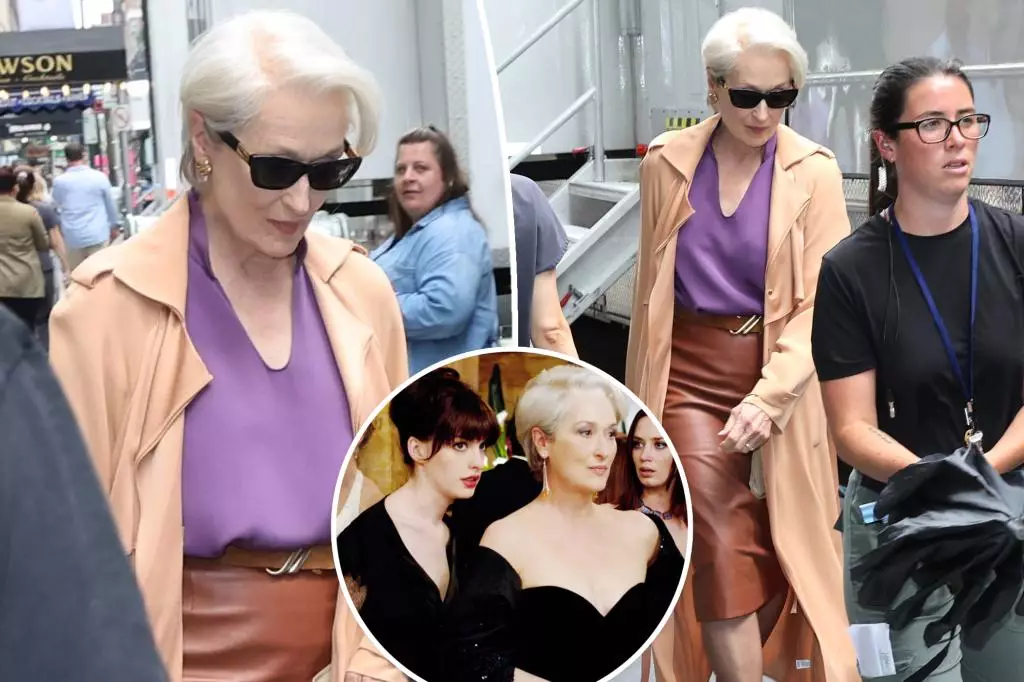After years of anticipation and cinematic silence, the formidable figure of Miranda Priestly is making her triumphant return. Meryl Streep, whose portrayal of the icy editor-in-chief in the original “The Devil Wears Prada” cemented her status as a cultural phenomenon, has been spotted on set once again. Her presence signals more than just a sequel; it signifies a reevaluation of what it means to wield power with sophistication and ruthless elegance. Streep’s appearance in New York City, donning her signature platinum pixie cut and an impeccably tailored outfit, underscores her unwavering commitment to embodying the quintessential boss—poised, commanding, and undeniably stylish.
This resurgence is not merely nostalgic; it underscores the evolving narrative of corporate ambition and personal reinvention. Priestly, as a character, symbolizes the archetype of unassailable authority cloaked in sartorial perfection. Her return invites audiences to witness the character’s transformation amidst an industry in flux. The fact that she continues to channel her role with such authenticity suggests that the legacy of Miranda Priestly transcends the screens of the early 2000s.
A Reflection of Industry Shifts and Personal Growth
The sequel’s plot reportedly explores Priestly’s navigation through the decline of traditional print media, a reality reflecting the seismic shifts in the publishing world. Her ongoing rivalry with Emily (Emily Blunt), now a top-tier executive, stands as a mirror to industry power struggles and personal resilience. Hathaway’s Andy Sachs continues her journey as well, with her fashionable evolution paralleling her growth as a character.
What is particularly intriguing about this sequel is its acknowledgment of an industry in transition, where old paradigms clash with new digital realities. Priestly’s character, typically associated with an unassailable position, is now depicted as adapting to a landscape where authority is more fragile, yet perhaps more complex. Her sartorial choices—an elegant tan trench, tailored skirts, and signature sunglasses—are a visual testament to her mastery in blending power with finesse. These details suggest a nuanced portrayal of a woman who symbolizes both dominance and adaptability, challenging the stereotype of static authority.
The Power of Fashion as Storytelling
Fashion remains a central element driving the narrative, serving as both armor and statement. Hathaway’s glimpses in bold, colorful outfits hint at her character’s desire for reinvention and independence. As she wears a vibrant patchwork maxi dress and vintage Gaultier vest, the costumes underscore her evolution from naïveté to confidence. The recurring motif of the iconic cerulean sweater, which Hathaway’s Andy wears in a TikTok clip, pays homage to the original film’s signature look, forging a tangible connection across decades.
This deliberate focus on style as a storytelling device elevates the narrative beyond mere plot. It positions fashion as a language of power—each outfit carefully selected to communicate status, intent, and transformation. In a world that increasingly values visual storytelling, the film’s emphasis on clothing underscores a deeper message: that appearance is an extension of authority, intelligence, and personal identity.
The Future of Sophistication and Authority
The casting of new characters, including Kenneth Branagh and Lucy Liu, indicates a deliberate expansion of the story’s universe—adding layers of complexity to Priestly’s world. Her relationship with her new husband, played by Branagh, introduces personal dimension to a character often viewed solely through her professional veneer. It suggests a desire to explore how personal life intersects with the relentless pursuit of success—a topic equally relevant today.
While Streep once expressed her discomfort in embodying such a frosty persona, her continued engagement suggests an evolving understanding of that character. The sequel promises to peel back more layers, challenging audiences to reexamine their perceptions of power, success, and authenticity. Priestly’s return is not just about reliving a bygone era of fashion and influence; it’s about redefining what it means to lead with strength and grace in a world that values both tradition and innovation.
The premiere set for May 2026 signals that Hollywood intends to give this story the grand stage it deserves, not merely as a sequel but as a reflection of shifting paradigms within industries and individuals alike. In this reinvigoration of Miranda Priestly, there lies a potent reminder: true authority combines resilience, style, and the courage to adapt—traits that continue to inspire audiences and reshape the cultural landscape.

